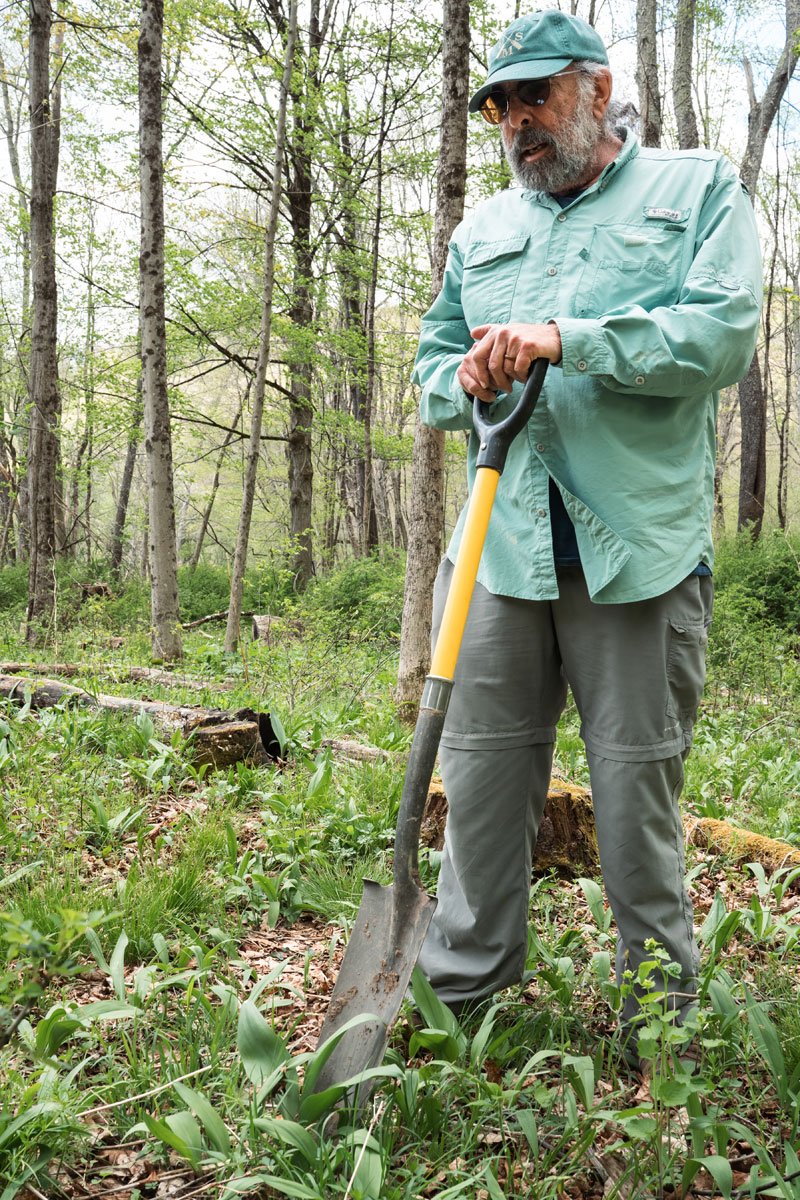“It’s the test of the hypothesis that you can eat your ramp and plant it, too,” Schwartz said as he surveyed the ramps in one of the study plots. “And it looks like it’ll work.”
Rooted in Culture
Ramps have long been an important wild food for Indigenous cultures, often consumed therapeutically to treat colds, earaches, and infections. They are welcomed as the first green vegetable in the spring to replenish vitamins and nutrients after a winter of dried and preserved foods.
Karelle Hall, an assistant professor of anthropology at the University of Massachusetts at Boston and a member of the Nanticoke Tribe of Delaware, visited Schwartz’s property this spring as part of a broader effort to relearn ancestral traditions and get more people in her community to engage with ramps and other culturally significant foods, she said. A cousin who joined her that day operates the Native Roots Farm Foundation, focused on reconnecting Indigenous communities with their plant relatives.
Although she’d purchased them before at farmers’ markets, it was Hall’s first time harvesting ramps herself. It felt particularly significant to do so right beside the headwaters of the Delaware River, which supported the Nanticoke and Lenape tribes in pre-colonial times, she said. With her harvest, she made soups and stews, ramp butter to eat with a venison roast, and ramp salt that she’ll share with relatives to strengthen her community’s connection to the plant.
The approach to harvesting that she saw at Delaware Valley Ramps echoes the practices central to Indigenous relationships with the natural world, she said. The Eastern Band of Cherokee Indians, for example, advocate taking just the leaves so bulbs can continue to propagate.
The gentle manipulation of a landscape can help a plant species feel more at home, encouraging it to grow into the space it’s allowed, Hall explained, as long as one rule is always followed: “Never deplete it to the point that it can’t repopulate itself.”
Jeanine Davis, an associate professor in horticultural science at North Carolina State University, has kept that principle in mind for more than 30 years, ever since a botanist in her state government asked for her help studying ramps as concerns grew about their declining population.
Within a decade, Great Smoky Mountains National Park, straddling North Carolina and Tennessee, made ramp harvesting illegal; three national parks in West Virginia followed suit in 2022. Although studies on the subject are scant, Burkhart said populations have diminished over time, but in Pennsylvania, at least, the issue is not overharvesting but the fact that favorable ramp habitats have been developed for other uses.
“Someday, if we continue doing this, we won’t have ramps. It would be one more piece of the forest that’s gone.”
Back when she started studying ramps, Davis said the general consensus was that they couldn’t be cultivated, but she helped show they can indeed be grown, given the right conditions—including slightly acidic, moist soil and sufficient shade. She’s now researching how different harvest practices—say, the number of leaves or portion of a bulb taken—affect a population.
In addition to her work with the plants themselves, Davis has studied the role they play in the mountain communities that have celebrated ramps for generations. There, she said, they are “like a spring tonic,” rich in nutrients and minerals, including vitamins A and C. A 2000 study, she noted, found that thanks to their naturally high quantities of selenium, ramps have the potential to reduce cancer in humans.
Davis remembers the “mind-boggling” volume of ramps she saw the first time she attended one of many annual festivals in Richwood, West Virginia, about 25 years ago. “Pickup truck after pickup truck full of them,” she recalled. She was impressed by how the festival was truly a community effort, with the entire town seemingly involved in some way.
In time, though, as ramps gained broader popularity, “What we’d always thought of as a food for country people, hunters, and fishermen was suddenly a gourmet item,” she said. Although she’s enjoyed seeing more people appreciate the plant, its success poses a challenge for conservation efforts.
Sharing an Ecosystem
On Schwartz’s property, ramps are part of a spring understory populated by fiddlehead ferns, morel mushrooms, and flowering trilliums and bloodroot—the type of biological diversity that indicates a healthy forest ecosystem, according to James Chamberlain, a retired research scientist with the U.S. Forest Service who studied ramps for 25 years. Given the ramp’s fickle growth habits, its presence in a landscape suggests a stable and supportive tree canopy and healthy soil.

Steve Schwartz considers himself an accidental forager. Eighteen years ago, he bought a property in Equinunk, Pennsylvania, to gain access to the Delaware River’s vaunted wild trout fishing. Then he discovered ramps growing abundantly on his property and has been selling them since 2008. (Photo credit: Ben Seal)
But Chamberlain worries that ramps may soon go the way of ginseng, another plant once abundant in the Appalachians that he said has been “genetically extirpated from the forest” by unsustainable harvest practices.
“Someday, if we continue doing this, we won’t have ramps,” Chamberlain said. “It would be one more piece of the forest that’s gone.”